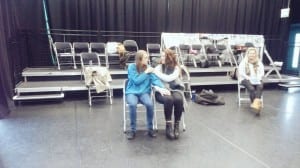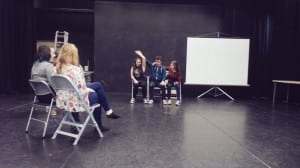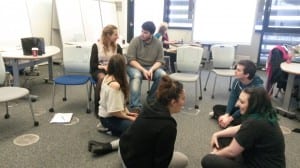As a company, Forefront Theatre want to use the words of others to create a performance piece which reflects other people as well as us. In order to do this we had to think of ways to portray their words in a respectful and honest manner. So, we chose to look at Verbatim theatre to help with this.
In a previous rehearsal, our writers had interviewed the Forefront Theatre Company members to help with their writing and I had recorded them so as to use the audio in a possible scene for our production. Using this idea Rachael Caulton, our dramaturg, put forward headphone verbatim theatre as a suggestion and so these recordings were experimented with in that way.
All performers were asked to pick someone else’s answers and listen to them. Once they had listened to the audio, I then told them to repeat what they were hearing as they were hearing it. I did not want the performers to mimic the accent they were hearing but instead to match the words and rhythm of the voice. To pretend to be the person would be difficult and is not necessary as the words are important in our piece not the accent of the voice.

Listen from Webley (2015)
This rehearsal was very productive and headphone verbatim theatre proved a challenge but is definitely worth pursuing by our company. It helped the performers develop their understanding of verbatim and experience how to perform it to an audience in a stylised manner on stage.
Tamsyn.
Work Cited:
Webley, T (2015) Listen



